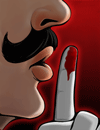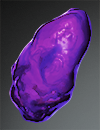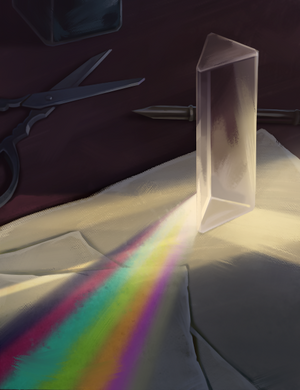Slobgollion

|
Beyond this point lie major spoilers for Fallen London, Sunless Sea, Sunless Skies, or Mask of the Rose. This may include endgame or major Fate-locked spoilers. Proceed at your own risk. You can find out more about our spoiler policy here. |
"Perhaps you'll never pronounce it quite like a Rubbery Man, but you finally know what 'slobgollion' means. It's the colour that oozes between life and death. Most humans will never perceive it, but for the first time, you're aware when you cross the threshold. Death's Country is always right here, cloaked by a colour that no living mind can fathom."[1]
Slobgollion is the Rubbery name[2] - or the closest approximation, anyway[3] - for a color that is simply unfathomable to humans. Existing just beyond the edge of the Neathbow, it is woven into the "net-of-the-world,"[4] the veil that separates the land of the living from Death's Country; this property renders the latter imperceptible to living creatures, despite the fact that Death's Country shares a physical space with the living world.[5]
Beyond the Visible Spectrum of Forbidden Light

"Just as blue might suggest sorrow; or red, anger; or green, tranquility; so, too, does slobgollion evoke emotions. But they aren't emotions that you're shaped to experience. You lack the synapses, the glands, and the lobes that would translate the pain into something different."[1]
The fact that Death is strange in the Neath is well-documented. Many of its now-permanent residents have spent some time in a slow boat passing a dark beach on a silent river. What none will tell, however, is the tale of their journey there.[6] This journey cannot be remembered, for it passes through the slobgollion barrier that covers the net-of-the-world, and slobgollion cannot be fathomed by the human mind.[5]
The nonhuman mind, however, is more flexible. The Rubbery Men are known to have many organs which science has not yet described nor understood. Furthermore, they are able to transfer some portion of their experiences and emotions to humans through the trade of amber.[7] While this may be a means of perceiving slobgollion, it would not be advisable to attempt such an experiment: slobgollion covers more than the net-of-the-world. Things which have known death become tainted with the color, and to perceive it at all is damaging to the human psyche thanks to its eldritch and incomprehensible nature.[8] It is a mercy, then, that the inhabitants of Death's Country do not wish to be perceived by the living, and will confiscate Dead Amber on sight.[9]
Cultural and Scientific Inspirations

Since it exists beyond the Neathbow, "between irrigo and oblivion," slobgollion is comparable to ultraviolet and/or infrared radiation - frequencies that exist beyond each edge of the visible (to humans) spectrum of light. The existing artwork of the Neathbow would indicate, when compared to the visible spectrum of light as seen through a prism, that slobgollion lies between irrigo and gant as a lower "frequency" more comparable to infrared.
Some types of snakes and bats can detect infrared radiation, and a few species of fish have been reported to be able to see near-infrared light. Insects and some non-human mammals can see near-ultraviolet light, and butterflies use it to communicate. Birds take this to the next level, as they have an entire fourth color receptor for ultraviolet rays (though only some have proper UV vision). Many birds also have specific patterns in their plumage that are only visible under UV light.
The term "slobgollion" is used in Herman Melville's novel Moby Dick to describe the remains of a sperm whale - hence the Implacable Detective's comment about spermaceti.[3] Legend has it that the term is whaler slang, but the veracity of this statement is unknown. Others propose that Melville meant to refer to (or conflate) "slumgullion," a term for meat stew, and/or "slubberdegullion," a term for a slobbering and unhygienic person.
References
|